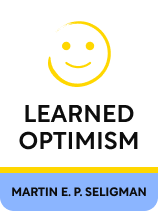

This article is an excerpt from the Shortform book guide to "Learned Optimism" by Martin E. P. Seligman. Shortform has the world's best summaries and analyses of books you should be reading.
Like this article? Sign up for a free trial here.
How does Martin Seligman define learned optimism? What is an optimistic mindset? How can you learn to be more optimistic?
Psychologist Martin Seligman coined the term “learned optimism” as a way of demonstrating that the traits of an optimistic person can be learned by anyone, even natural pessimists. In his book, Learned Optimism, Seligman explains the concept of learned optimism, including techniques for breaking out of a pessimistic mindset.
Read on to learn Seligman’s definition of learned optimism, plus how you can teach yourself optimism.
What Is Learned Optimism?
Many people suffer from learned helplessness: the belief that they don’t have the power to make positive changes in their own lives or in the world around them. Martin Seligman defines learned optimism as a way of teaching yourself how to break out of a pessimistic, powerless mindset and replacing it with an empowered mindset of optimism and confidence.
Seligman is a professional psychologist, teacher, and author. His theories of learned helplessness and learned optimism are based on his own laboratory studies. He began these studies in the 1960s and has continued tweaking and reexamining them to the present day.
Seligman’s theory of learned helplessness has become widespread, both in the field of psychology and among laypeople. However, Learned Optimism was published in 1990, and there have been significant advances in the field of psychology since then. Our commentary will explore those new developments as needed, provide a grounding in core concepts of psychology, and offer actionable advice.
How to Learn Optimism
According to Martin Seligman’s definition of learned optimism, optimists tend to generalize and personalize positive events. When something good happens, they think it’s because of their own abilities, or simply because good things always happen to them. Conversely, when something bad happens, they see it as a temporary setback due to external causes—they’ll say something like, “Things didn’t work out this time.”
(Shortform note: According to Dweck, the opposite of a fixed mindset is a growth mindset. In simple terms, someone with a growth mindset believes that people can change; they can improve their skills and their attitudes in order to make positive changes in the world around them. A growth mindset goes hand-in-hand with optimism because someone with a growth mindset will see problems as temporary setbacks—challenges to overcome—instead of fixed and unchangeable truths about the world.)
1. Examining Your Beliefs
The definition of learned optimism includes cultivating a positive mindset. Seligman offers a couple of techniques, drawn from cognitive therapy, to help you become more optimistic by changing the way you explain negative events to yourself. The first technique is to examine your belief.
Start this process by asking yourself if what you believe is really true. What evidence is there for it and against it? After considering that evidence, does your belief seem rational? Also, ask what the implications of your belief are. In other words, if it were true, what would that mean for you? Conversely, what would it mean for you if you were wrong?
Once you’ve considered whether your belief is true or not, and what that means for you, think about if your belief is useful. Does it empower you, energize you, or help you prepare for the future? If not, is it worth holding on to this belief? On that note, think about some different beliefs you could replace it with. How else might you interpret the event in question? Is there an explanation that doesn’t depend on something being wrong with you?
(Shortform note: While useful for reframing your thoughts, Seligman’s process here doesn’t suggest any course of action you can take based on your beliefs. To that end, in The 4-Hour Workweek, entrepreneur and lifestyle guru Tim Ferriss suggests another useful question to ask yourself in stressful or worrisome situations: What will I do about it? In other words, if the belief that you’re worrying about actually turns out to be true, how would you handle it? Planning for the worst can help you stay calm and confident, as long as you don’t keep dwelling on the worst once your plan is in place.)
2. Using an External Voice
Along with Seligman’s definition of learned optimism, he also explains the dangers of a negative internal voice. For that reason, the second technique is to give pessimistic beliefs an external voice. Find a friend who’s willing to roleplay your negative beliefs. Have that person attack you the same way you attack yourself, and learn to defend yourself from that sort of aggression. You may find it easier to fight back against an external voice, and having to defend yourself out loud might help you to hear how fair and reasonable those defenses really sound.
(Shortform note: Another way of coming to terms with that negative voice in your head is to give it a silly name and a silly voice. In short, turn your inner critic into a character you can’t take seriously, and it will lose its power over you—for example, it’s hard to feel worried or upset when your inner critic sounds like Skeletor.)

———End of Preview———
Like what you just read? Read the rest of the world's best book summary and analysis of Martin E. P. Seligman's "Learned Optimism" at Shortform.
Here's what you'll find in our full Learned Optimism summary:
- How to break out of a pessimistic, powerless mindset
- How to develop a mindset of empowerment, optimism, and confidence
- How to balance your optimism with realism






